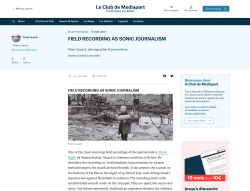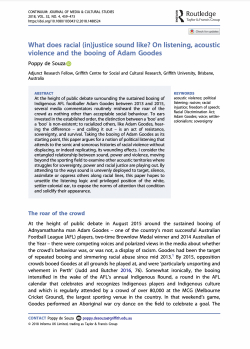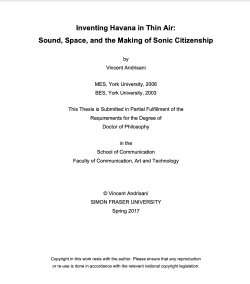'The Scream': Israel Blasts Protesters With Sonic Gun

Type
News Clipping
Authors
Rawnsley ( Adam Rawnsley )
Category
Article
[ Browse Items ]
Publication Year
2011
Publisher
WIRED, United States
URL
[ private ]
Tags
Abstract
Flashlights with puke rays. Mobile microwave pain beams. The world of less-than-lethal weapons is filled with exotic and just plain weird devices to annoy and thwart enemies. Now, Israel’s throwing its hat in the ring with another, called “the Scream.” The Jerusalem Post reports that Israeli forces unleashed a new(ish) less-than-lethal weapon on stone throwers.
at a violent checkpoint demonstration on Thursday. The Scream is a vehicle-mounted sonic blaster that shoots repeated pulses of sound at targets, leaving them dizzy and nauseous.
The rollout of the Scream, according to the Post, is part of a new counter-demonstration effort led by the IDF's Maj. Gen. Avi Mizrahi. Mizrahi is trying to use more less-than-lethal technology against Palestinian protesters to cut down the risk of an accidental death creating a rallying cry at a volatile time in the region.
While accounts of the Scream's use at Qalandia pointed to it as a first for Israel, the Israeli Defense Force has actually used a sonic blaster dubbed "the Scream" at least once before. In 2005, the IDF deployed a "Scream" sonic blaster on a protest against Israel's separation barrier that turned violent. Israel's Electro-Optics Research & Development Ltd. company makes an "anti-riot system" that it calls "SHOPHAR The scream." Named after the ram's horn blown during Jewish religious ceremonies -- including next week's Rosh Ha'shannah services -- the SHOPHAR uses a stack of 36 hexagonal horns to blast a concentrated beam of sound at targets as far away as 75 meters. "The system is operational in the IDF," the company says. It's not clear whether all these systems are the same, or just have similar names.
Either way, the technology behind these weapons isn't exactly brand spanking new. The Long Range Acoustic Device (LRAD), a farther-reaching sonic blaster, has been a handy anti-pirate and anti-riot weapon for years now. The LRAD, which looks like a frying pan attached to a swivel, fires a beam of 150 decibels worth of noise to rattle skulls at distances of up to 300 meters. Ships like the Maersk Alabama and the cruise liner MSC Melody have used it to ward off oncoming pirate skiffs while transiting the dangerous waters off the coast of Somalia. In the U.S., it's also been used to ward off rowdy protesters, like during G20 demonstrations in Pittsburgh in 2009. American Technology Corp, the company that makes the LRAD, has also tried to make a bazooka version of its sonic blaster.
Israel less-lethal includes a few choice weapons. The "Thunder Generator" is a sonic blaster so loud you could actually die from it. The thunder machine uses liquefied petroleum gas to make loud explosions -- up to 100 per minute -- like a repeating flashbang grenade. It works up to 50 meters away, but stand within 10 meters and Thunder's makers warn it can permanently injure or even kill you.
Other technologies at Israel's disposal include the "skunk bomb," effectively a large stink bomb that leaves the affected smelling like sewage. Targets who've been skunked have reported that the smell is hard to remove, even after a shower.
But sonic blasters aren't the only piece of kit that's getting attention in Israel. Danger Room pal Eli Lake has a scoop on the Obama administration's secret sale of 55 GBU-28 bunker buster bombs to Israel. The sale is significant because of its implications for an attack on Iran's nuclear program. For the longest time, it was thought that Israel couldn't mount an effective strike on the Iranian program because it didn't have powerful enough munitions to blast underground and reach Iran's buried facilities. The roughly 5,000 lb. GBU-28s, however, can burrow through 100 feet of ground before detonating.
at a violent checkpoint demonstration on Thursday. The Scream is a vehicle-mounted sonic blaster that shoots repeated pulses of sound at targets, leaving them dizzy and nauseous.
The rollout of the Scream, according to the Post, is part of a new counter-demonstration effort led by the IDF's Maj. Gen. Avi Mizrahi. Mizrahi is trying to use more less-than-lethal technology against Palestinian protesters to cut down the risk of an accidental death creating a rallying cry at a volatile time in the region.
While accounts of the Scream's use at Qalandia pointed to it as a first for Israel, the Israeli Defense Force has actually used a sonic blaster dubbed "the Scream" at least once before. In 2005, the IDF deployed a "Scream" sonic blaster on a protest against Israel's separation barrier that turned violent. Israel's Electro-Optics Research & Development Ltd. company makes an "anti-riot system" that it calls "SHOPHAR The scream." Named after the ram's horn blown during Jewish religious ceremonies -- including next week's Rosh Ha'shannah services -- the SHOPHAR uses a stack of 36 hexagonal horns to blast a concentrated beam of sound at targets as far away as 75 meters. "The system is operational in the IDF," the company says. It's not clear whether all these systems are the same, or just have similar names.
Either way, the technology behind these weapons isn't exactly brand spanking new. The Long Range Acoustic Device (LRAD), a farther-reaching sonic blaster, has been a handy anti-pirate and anti-riot weapon for years now. The LRAD, which looks like a frying pan attached to a swivel, fires a beam of 150 decibels worth of noise to rattle skulls at distances of up to 300 meters. Ships like the Maersk Alabama and the cruise liner MSC Melody have used it to ward off oncoming pirate skiffs while transiting the dangerous waters off the coast of Somalia. In the U.S., it's also been used to ward off rowdy protesters, like during G20 demonstrations in Pittsburgh in 2009. American Technology Corp, the company that makes the LRAD, has also tried to make a bazooka version of its sonic blaster.
Israel less-lethal includes a few choice weapons. The "Thunder Generator" is a sonic blaster so loud you could actually die from it. The thunder machine uses liquefied petroleum gas to make loud explosions -- up to 100 per minute -- like a repeating flashbang grenade. It works up to 50 meters away, but stand within 10 meters and Thunder's makers warn it can permanently injure or even kill you.
Other technologies at Israel's disposal include the "skunk bomb," effectively a large stink bomb that leaves the affected smelling like sewage. Targets who've been skunked have reported that the smell is hard to remove, even after a shower.
But sonic blasters aren't the only piece of kit that's getting attention in Israel. Danger Room pal Eli Lake has a scoop on the Obama administration's secret sale of 55 GBU-28 bunker buster bombs to Israel. The sale is significant because of its implications for an attack on Iran's nuclear program. For the longest time, it was thought that Israel couldn't mount an effective strike on the Iranian program because it didn't have powerful enough munitions to blast underground and reach Iran's buried facilities. The roughly 5,000 lb. GBU-28s, however, can burrow through 100 feet of ground before detonating.
Description
https://www.wired.com/2011/09/the-scream-israel-blasts-rioters-with-sonic-gun/
Number of Copies
1
| Library | Accession No | Call No | Copy No | Edition | Location | Availability |
|---|---|---|---|---|---|---|
| Main | 663 | 1 | Yes |




